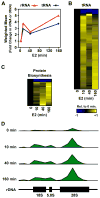A rapid, extensive, and transient transcriptional response to estrogen signaling in breast cancer cells
- PMID: 21549415
- PMCID: PMC3099127
- DOI: 10.1016/j.cell.2011.03.042
A rapid, extensive, and transient transcriptional response to estrogen signaling in breast cancer cells
Erratum in
- Cell. 2011 Jun 24;145(7):1156
Abstract
We report the immediate effects of estrogen signaling on the transcriptome of breast cancer cells using global run-on and sequencing (GRO-seq). The data were analyzed using a new bioinformatic approach that allowed us to identify transcripts directly from the GRO-seq data. We found that estrogen signaling directly regulates a strikingly large fraction of the transcriptome in a rapid, robust, and unexpectedly transient manner. In addition to protein-coding genes, estrogen regulates the distribution and activity of all three RNA polymerases and virtually every class of noncoding RNA that has been described to date. We also identified a large number of previously undetected estrogen-regulated intergenic transcripts, many of which are found proximal to estrogen receptor binding sites. Collectively, our results provide the most comprehensive measurement of the primary and immediate estrogen effects to date and a resource for understanding rapid signal-dependent transcription in other systems.
Copyright © 2011 Elsevier Inc. All rights reserved.
Figures







Comment in
-
A hormone sends instant messages to the genome.Cell. 2011 May 13;145(4):499-501. doi: 10.1016/j.cell.2011.04.016. Cell. 2011. PMID: 21565609
References
-
- Acevedo ML, Kraus WL. Transcriptional activation by nuclear receptors. Essays Biochem. 2004;40:73–88. - PubMed
-
- Beissbarth T, Speed TP. GOstat: find statistically overrepresented Gene Ontologies within a group of genes. Bioinformatics. 2004;20:1464–1465. - PubMed
-
- Carroll JS, Liu XS, Brodsky AS, Li W, Meyer CA, Szary AJ, Eeckhoute J, Shao W, Hestermann EV, Geistlinger TR, et al. Chromosome-wide mapping of estrogen receptor binding reveals long-range regulation requiring the forkhead protein FoxA1. Cell. 2005;122:33–43. - PubMed
-
- Carroll JS, Meyer CA, Song J, Li W, Geistlinger TR, Eeckhoute J, Brodsky AS, Keeton EK, Fertuck KC, Hall GF, et al. Genome-wide analysis of estrogen receptor binding sites. Nat Genet. 2006;38:1289–1297. - PubMed
Publication types
MeSH terms
Substances
Associated data
- Actions
Grants and funding
LinkOut - more resources
Full Text Sources
Other Literature Sources
Medical
Molecular Biology Databases

